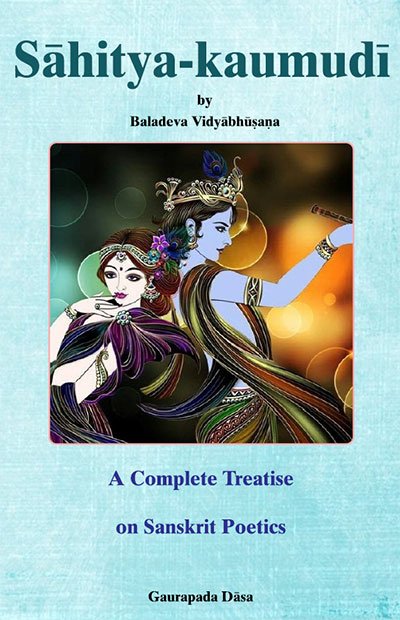Sahitya-kaumudi by Baladeva Vidyabhushana
by Gaurapada Dāsa | 2015 | 234,703 words
Baladeva Vidyabhusana’s Sahitya-kaumudi covers all aspects of poetical theory except the topic of dramaturgy. All the definitions of poetical concepts are taken from Mammata’s Kavya-prakasha, the most authoritative work on Sanskrit poetical rhetoric. Baladeva Vidyabhushana added the eleventh chapter, where he expounds additional ornaments from Visv...
Text 7.152
[This is an example of a nonfaulty usage of a rasa which is adverse to the contextual rasa,]
प्रत्याहृत्य मुनिः क्षणं विषयतो यस्मिन् मनो धित्सते
बालासौ विषयेषु धित्सति ततः प्रत्याहरन्ती मनः |
यस्य स्फूर्ति-लवाय हन्त हृदये योगी सुमुत्कण्ठते
मुग्धेयं किल तस्य पश्य हृदयान् निष्क्रान्तिम् आकाङ्क्षति ||
pratyāhṛtya muniḥ kṣaṇaṃ viṣayato yasmin mano dhitsate
bālāsau viṣayeṣu dhitsati tataḥ pratyāharantī manaḥ |
yasya sphūrti-lavāya hanta hṛdaye yogī sumutkaṇṭhate
mugdheyaṃ kila tasya paśya hṛdayān niṣkrāntim ākāṅkṣati ||
pratyāhṛtya—after withdrawing; muniḥ—a sage; kṣaṇam—for a moment; viṣayataḥ—from sensory objects; yasmin—in whom; manaḥ—the mind; dhitsate—desires to fix; bālā—woman; asau—that; viṣayeṣu—on sensory objects; dhitsati—desires to fix; tataḥ—from Him; pratyāharantī—to withdraw; manaḥ—the mind; yasya—of whom; sphūrti—of a vision; lavāya—for a fraction; hanta—alas; hṛdaye—in the heart; yogī—a yogī; sumutkaṇṭhate—longs; mugdhā—simple woman; iyam—this; kila—indeed; tasya—His; paśya—see; hṛdayāt—from the heart; niṣkrāntim—departure; ākāṅkṣati—wants.
[Paurṇamāsī tells Nandīmukhī about Rādhā’s love:]
A muni desires to withdraw his mind from sensory objects and fix it on Kṛṣṇa for a moment, but this woman wants to fix Her mind on sensory objects to withdraw it from Him. Alas, a yogī longs to see Him in his heart for even a fraction of a second, but, just see, this simple woman wants Him to leave Her heart. (Vidagdha-mādhava 2.17) (Bhakti-rasāmṛta-sindhu 4.8.65) (Ujjvala-nīlamaṇi 15.37)
atra śāntasya bādhyatayoktiḥ prakṛta-śṛṅgāra-puṣṭi-kṛt.
Here the mention of śānta-rasa as being suppressed makes the enhancement of śṛṅgāra, the contextual rasa.
Commentary:
Moreover, Mammaṭa exemplifies the proper usage of an adverse vibhāva,
satyaṃ manoramā rāmāḥ satyaṃ ramyā vibhūtayaḥ |
kintu mattāṅganāpāṅga-bhaṅga-lolaṃ hi jīvitam ||“It’s true, beautiful women captivate the heart, and truly, money is nice, yet life is as fleeting as a crooked sidelong glance of a flirtatious young woman” (Dhvanyāloka 3.30) (Kāvya-prakāśa, verse 333).
The statement in the first half “It is true, beautiful woman are pleasing” is an uddīpana of śṛṅgāra-rasa and is suppressed by the purport of the verse, expressed in the second half. A crooked sidelong glance is even more transitory than life, and that transitoriness only enhances śānta-rasa. Mammaṭa adds that there is no śṛṅgāra-rasa here because an aspect of it, that uddīpana, makes no sense in the context.[1] According to Govinda Ṭhakkura, here the suppression heightens śānta-rasa and therefore makes a literary quality (embellishment): atra pūrvārdhe śṛṅgārasya parārdhe śāntasya vibhāvaḥ. anayor virodhe’pi pūrvārdhasya bādhyatvenaivoktatvān na doṣatvam, pratyuta śānta-paripoṣaṇād guṇatvam (Kāvya-pradīpa).
Footnotes and references:
[1]:
atrādyam ardhaṃ bādhyatvenaivoktam. jīvitād api adhikam apāṅga-bhaṅgasyāsthiratvam iti prasiddha-bhaṅguropamānatayopāttaṃ śāntam eva puṣṇāti, na punaḥ śṛṅgārasyātra pratītis tad-aṅgāpratipatteḥ (Kāvya-prakāśa, verse 333 vṛtti).
